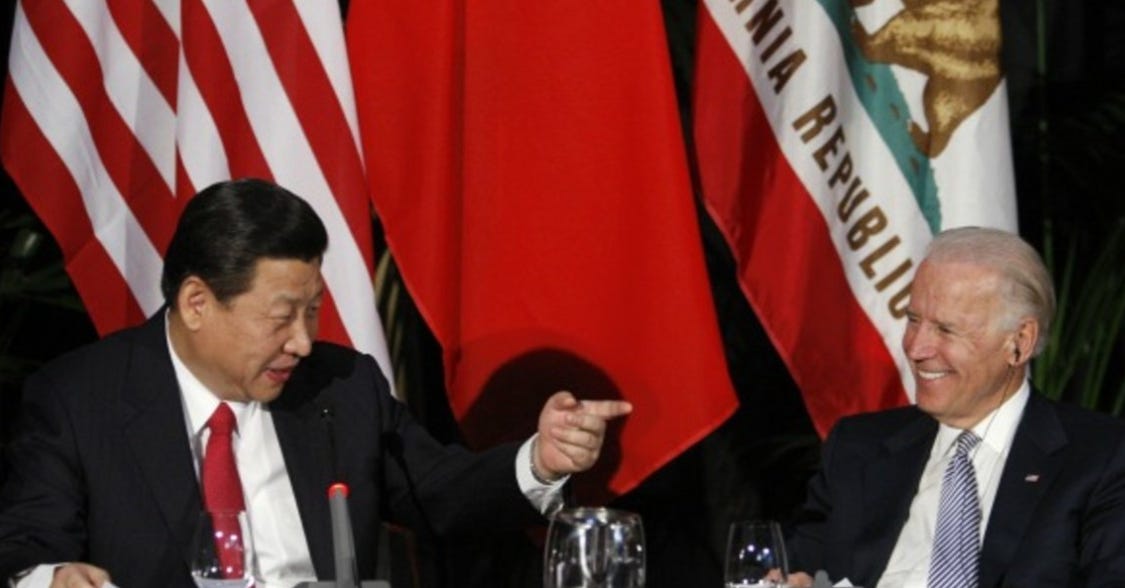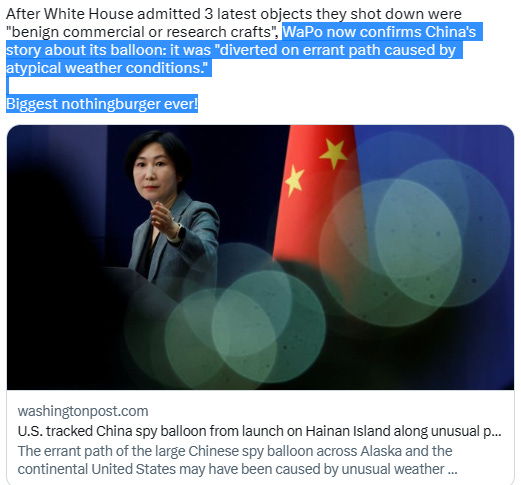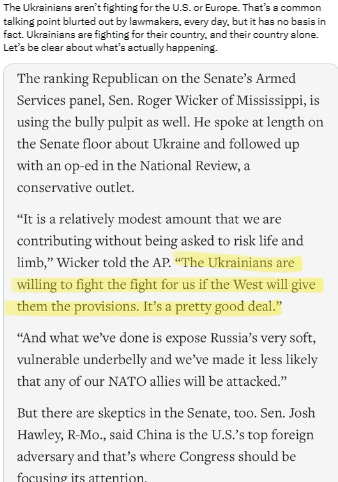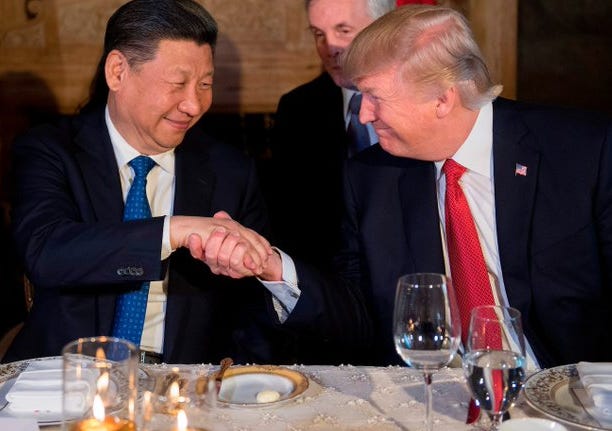Soekarno had dreamed about non-alignment since the decade of the 50s. He created “another’ Olympics (name: Games of New Emerging Forces Country), with the masterpiece (now popular with name) Stadion Gelora Bung Karno. He build “CONEFO” (Conference of New Emerging Forces countries), new format of United Nation, with the masterpiece building now is The Main Hall of Indonesia Parliamentary (In Indonesia slang, called “Gedung Kura-Kura / A Turtle Building, because the roof similar with Turtle). The latest saga, 4 objects unidentified flying (40 minutes ago, U.S. government using “object”, no longer balloon, because, cited John Kirby, “has not yet been able to identify”) in U.S. and Canada airspace vs 10 flying objects (acclaimed by China all - more than 10 objects owned by and controlled by U.S Government), is a new sign of (search of) non-alignment. Two superpowers try to beat each other, and redefine how every country in the earth identifies “non-alignment” or not.
In his National Security Strategy, U.S. President Joe Biden outlined his view of global competition with China and the American desire to “work in lockstep with our allies and partners and with all those who share our interests. But this desire for cooperation faces an obvious problem: Many countries would rather not choose sides, and they gain leverage from playing great powers off each other. The problem is especially acute in regions where America’s emphasis on liberal democracy contradicts the interests of some of the regions’ governments.
This policy brief focuses on China’s engagement with these new “non-aligned” countries in global competition, especially countries in South Asia, the Middle East, and the Horn of Africa. There is a risk of taking Cold War analogies — such as non-alignment — too far, of course. Here we mean countries that prefer a less-then-clear alignment with the United States or China. China’s relationship with Pakistan is examined closely, as it may best exemplify Beijing’s model for dealing with such countries, but it is important to recognize that China has no one-size-fits-all approach to great power competition and, therefore, neither should the United States.
In many countries, China has used extensive economic engagement as a prequel and precursor for strategic and political influence — using economic clout to yield a strategic advantage. Beijing’s model is truly global: As one senior Western official put it, “They are putting their pieces all over the board.” The model meets the needs of regional countries that are seeking to diversify their relationships in what they perceive as an increasingly multipolar world. These factors present a challenge as well as an opportunity for U.S. policy.
U.S. diplomacy seems like it is either standing still or so mired in domestic dysfunction that it can no longer compete. Meanwhile, China is throwing an ever-increasing amount of resources at diplomacy.
Over the past decade, China has increased its spending on diplomacy and even surpassed the United States in the number of diplomatic posts it has worldwide. It appears to have grown its number of diplomats, and they are far better trained and more assertive than their predecessors, including at multilateral organizations like the United Nations. U.S. spending on diplomacy, meanwhile, has stayed effectively flat, as has the size of the U.S. Foreign Service, while funding, security and other factors have limited America’s diplomatic footprint abroad….
China’s intense focus on “commercial diplomacy,” which includes promoting trade deals and infrastructure projects, gives its envoys an edge, especially in Latin American and African countries that feel neglected by Washington. U.S. government initiatives to counter China’s infrastructure programs are not easily accessed or as well-funded. The U.S. diplomatic tradition, meanwhile, has de-emphasized the commercial element. The relatively few U.S. diplomats who specialize in it rely heavily on a private sector that, unlike Chinese state-run firms, often won’t come through, especially in certain parts of the world.
The Chinese communist system may be repressive and rigid, but it is more steady than the trajectory of the United States, with long-term plans that can run decades. U.S. diplomacy, on the other hand, has become too capricious, unreliable and exposed to partisan deadlock, officials and analysts say. And CSIS simulation war 2026 make more complicated, and heated, between Washington DC and Beijing.
On ambassadorships and more, “domestic politics in the U.S. is undermining U.S. national interests throughout the world,”.
Biden already shook hands with Xi Jinping 24 hours before the G20 Summit in Bali Indonesia (Nov 15th, 2021). Then, Dec 15th 2022, The Biden administration launched “China House,” the centerpiece of its effort to strengthen its diplomatic heft in its global rivalry with Beijing.
The State Department-based unit is designed to eliminate silos among sometimes redundant government bodies, giving U.S. officials from within the State and beyond a central clearinghouse to share information and shape policy on China, State officials told.
The establishment of China House reflects the sense inside President Joe Biden’s team that the existing U.S. bureaucracy isn’t nimble enough to combat the multitude of challenges from communist-led China — ranging from trade to military power.
While it is essentially an internal reorganization, the creation of the unit has faced hurdles. Sen. Jim Risch of Idaho, the ranking Republican on the Senate Foreign Relations Committee, refused to sign off on the proposal for months, with his spokesperson saying it was structured as a “bureaucratic power grab.”
China House — formally known as the Office of China Coordination — replaces the China Desk in the State Department’s East Asian and Pacific Affairs bureau. The new entity will employ roughly 60 to 70 personnel, including liaisons from other parts of the department such as the Africa and Latin America bureaus, as well as people detailed from other U.S. departments and agencies who may focus on topics such as technology or economic policy.
“The sheer scale, scope, complexity and stakes of the China challenge required us to think, collaborate, organize and act differently,” a senior State Department official said. “It could not be managed alone through the bilateral desk approach.” The official spoke on condition of anonymity because the discussion involved sensitive diplomatic matters.
“China House will deepen our capacity to share information, sharpen our messaging, and adjust to breaking developments in real-time,” Deputy Secretary of State Wendy Sherman is due to tell State Department staffers on Friday, according to a draft note.
China is already investing heavily in its own diplomatic machine. It now has more diplomatic facilities overseas than the United States, according to one survey. Beijing’s spending on diplomacy has also soared in recent years and analysts say that has helped boost the quality and assertiveness of its diplomats.
U.S. spending on diplomacy, meanwhile, has remained effectively flat, as has the size of the U.S. Foreign Service, while funding, security and other factors have stymied America’s diplomatic presence.
The State Department plans won’t require new funding. Officials building it said they hope it will allow them to overcome bureaucratic hurdles that have excluded key personnel from policymaking processes and prevented information and analysis from reaching relevant diplomatic outposts and government agencies.
“The fact that we’re going to have a single, secure facility where the vast majority of people can be in at one time and participate in one conversation — I can’t overestimate to you how important that is,” the senior State Department official said. “We have not traditionally brought up our teams across the department in this way to do this kind of work.”
The State Department plan is somewhat analogous to the CIA’s creation of a China Mission Center as the spy agency expands its focus on the Asian giant. Both entities are designed to be centralized hubs to steer funding, resources and personnel to track China’s expanding global footprint.China House will be physically located inside the State Department’s headquarters in Foggy Bottom. It will have three main teams: one focused on traditional bilateral affairs; one that deals with strategic communications; and one dubbed a “global” team, which focuses on Chinese activity beyond China. A deputy assistant secretary, Rick Waters, will oversee China House as its inaugural coordinator, reporting to Assistant Secretary of State Dan Kritenbrink as well as Sherman, who oversees a high-level strategy group on China.
Former State Department officials, though broadly supportive of the need for greater resources targeting China, have warned that the China House may create a new layer of bureaucracy that will impede rather than improve efficient and timely State Department monitoring and analysis of Beijing’s activities.
Not everyone in Washington is freaking out about the suspected Chinese spy balloon, or now “OBJECTS”, flying high over the United States. Some former officials say it’s giving U.S. diplomats exactly what they need: more leverage over Beijing. That could give Blinken an edge in his efforts to prod Beijing to deliver meaningful results when he eventually travels to China.
John Kamm, who has decades of experience negotiating with Chinese officials in his role as founder of the Dui Hua prisoner advocacy organization, said “it puts pressure on China to do something as a goodwill gesture in response to what they’ve done.”
Much of Blinken’s planned two days with Chinese Foreign Minister Qin Gang — and a possible meeting with Xi — would have been lost to ritual recitations of respective U.S.-China positions on issues ranging from Taiwan and trade tensions to concerns about Beijing’s human rights record, its growing nuclear arsenal and its alignment with Russia’s war on Ukraine.
In an interview before the balloon was reported, David R. Stilwell, former assistant secretary of State for the Bureau of East Asian and Pacific Affairs, said the meeting was unlikely to produce movement on any of those issues. “Beijing uses ‘talks’ to reduce pressure — while giving nothing of significance — and to humiliate the other side,” Stillwell said.
Still, some say Blinken could have seized the opportunity to make heavier demands in person.
“If Tony went now, Xi and the Chinese would be deeply embarrassed, grateful that he came, wanting to put it behind him,” said Danny Russel, a former senior Asia hand in the Obama administration. The balloon incident could have become “a teachable moment,” he said.Delaying the trip risks the Chinese becoming more defensive over time, and less inclined to come to a meeting of the minds, said Russel, who nonetheless stressed that he understood the Biden administration’s calculations.
But time may not be on Blinken’s side given the crowded Chinese political calendar.
“The Chinese have their national legislative session in early March, and House Speaker [Kevin] McCarthy is projected to visit Taiwan around Easter, so the trip may not happen until the late spring, where the bilateral atmosphere arguably will be even more challenging,” said Chris Johnson, president and chief executive of the China Strategies Group, a risk consultancy.
Regardless of the spy balloon’s short-term diplomatic fallout and the possible short-term advantage Blinken could reap from it, the longer-term prospects for U.S.-China relations remain grim. Awkwardly, US-China trade defies talk of decoupling to hit record high in 2022.
Trade between the United States and China hit a record high in 2022, even as political tension heightened between the world’s top two economies.
The bilateral goods trade between the countries rose to $690.6 billion last year, according to official US data, which was released Tuesday.
Exports to China increased by $2.4 billion to $153.8 billion, while imports of Chinese products rose by $31.8 billion to $536.8 billion according to the US Bureau of Economic Analysis.
The data suggests that the idea of “decoupling,” or reducing mutual reliance in a range of areas, is much more evident in policy discussions in Washington rather than on-the-ground trade reality, according to analysts.
“Supply chains are sticky, particularly those linked to China,” Nick Marro, lead analyst for global trade at the Economist Intelligence Unit, told CNN.
“The US government is working to reduce its supply chain reliance on China, but at the end of the day, most companies care more about getting their products to consumers on time, and in ways that are the most cost-effective for their own operations.”
“Beijing is hoping talks provide a timeout from bilateral friction that allows it to focus on domestic issues; the U.S. wants China to agree to guardrails that allow relations to remain abrasive without getting too hot,” said Robert Daly, director of the Kissinger Institute on China and the United States at the Wilson Center. “Those goals are probably irreconcilable.”
Over the past 10 years, U.S. annual funding for the State Department, the U.S. Agency for International Development and related functions has, for all intents and purposes, stayed the same — floating around $55 billion.” I have heard far too many Foreign Service Officers talk about needing to cadge resources from their Department of Defense colleagues — because that’s where the money is.
Good explanation from the former acting Defense Secretary in Trump regime. Former acting Defense Secretary Christopher C. Miller has a message for Washington: cut the defense budget "dramatically" and stop making China a bogeyman.
Miller argues the Pentagon budget, now at $816 billion, could be slashed by as much as half.
"We have created an entire enterprise that focuses economically on creating crisis to justify outrageously high defense spending," Miller said in an interview with chief Washington correspondent Major Garrett for this week's episode of "The Takeout."
"You have to starve the beast to make people come out of their cubby holes and start thinking creatively," Miller said, adding that legacy weapons systems could be phased out in favor of newer, more efficient technology.
Miller served in the waning days of the Trump administration and recently wrote a book about his experience, "Soldier Secretary."
He suggests the military-industrial complex, a term first used by President Dwight Eisenhower to describe the symbiotic connection between a country's military and industrial bases, has spiraled to unsustainable levels and encouraged military and political leaders to exaggerate global conflicts.
He points to policymakers' approach to China as an example and argues they should de-emphasize the potential conflict.
"I think by constantly harping on the fact that China is the new threat and we're going to go to war with them someday actually plays right into Chairman Xi's hands and the Chinese Communist Party," Miller told Garrett. "They need to have an enemy that they can, you know, focus their people's anger and attention on and I think we provide them that opportunity by constantly harking on the fact that the Chinese are the greatest threat to America and what not."
The interview with Miller was recorded days before a suspected Chinese spy balloon (now: OBJECTS) traversed the continental United States.
Miller served as acting defense secretary for just 73 days. But his tenure included Jan. 6, 2021, a day he says is "still pretty raw" in his memory.
"It was a horrible day, nightmare day for the republic," Miller said, defending his agency's response to the unfolding chaos on Capitol Hill. "I felt that we did our duty and served our country appropriately."
Miller admits there were communications breakdowns amid "fog and friction" that day, and critics have blamed him for not dispatching troops to quell the violence sooner.
In a report on Jan. 6 prepared by the Defense Department inspector general, Miller said he feared that injecting military personnel into the fray would make the situation worse. "There was absolutely no way … I was putting U.S. military forces at the Capitol, period," Miller told the inspector general.
"If we put U.S. military personnel on the Capitol, I would have created the greatest Constitutional crisis probably since the Civil War," Miller said, suggesting President Trump could have used those troops to invoke martial law and attempt to hold on to power.
Back again about U.S. - China. The name of the game in the U.S. national security conversation is now unquestionably "China."
Just four months into President Joe Biden's term, even some conservatives have admitted the continuity between the Trump and Biden administrations with regard to America's foremost geopolitical competitor. The president's Interim National Security Strategic Guidance, issued in March, mentions China 15 times in its 20 pages of text. The administration's 2022 defense budget request, sent to Congress recently, proposes to handle China through measures like the largest research and development request in the history of the Department of Defense.
But if American national security attention is now fixed squarely on the People's Republic of China (PRC), then so are the interests of the innumerable stakeholders and program managers at the Department of Defense. It may be 30 years since America last won a war, but the Pentagon's record in staying well fed is far better. So China has quickly become a ubiquitous garnish on the defense menu, with hasty sinicization of every weapons system, program and deployment in America's bloated global defense posture.
In Europe, U.S. strategists are attempting to repurpose NATO as a bulwark against China. Never mind that most wealthy European countries free ride on American security guarantees and refuse to adequately fund their own militaries—surely Germany can spare some of its dwindling fleet for freedom of navigation patrols in the South China Sea? That Europeans seem uninterested in being dragged into a U.S.-China confrontation hasn't impeded this vision of a new mission for an archaic alliance.
Even as the Biden administration speaks of collective security in the Persian Gulf and attempts to renew the Joint Comprehensive Plan of Action nuclear deal with Iran, its own generals warn of China "filling a vacuum" in the region as the U.S. draws down. Despite $6 trillion wasted and more than 7,000 U.S. servicemen killed in wars of choice in the Greater Middle East, the Sino specter is being trotted out in an attempt to prevent any serious revision of the hoary Carter Doctrine. In 2020, the Middle East drew almost as much presence from U.S. aircraft carriers, America's crown jewels of power projection, as the entire Pacific. Afghanistan War dead-enders like Representative Adam Kinzinger (R-Ill.) have even invoked potential mineral concessions to China as a reason for continuing America's longest war.
China's presence in Africa is primarily commercial, with billions of dollars of annual foreign direct investment into infrastructure and the presence of a small but savvy expatriate merchant class. China now boasts a lone overseas military base in Djibouti, against 29 U.S. bases on the continent. This has led General Stephen Townsend, commander of U.S. Africa Command, to warn Congress that "China has invested heavily in their second continent, or as some think tanks call it, their fourth or fifth island chain."
Framing the U.S.-China competition as "the new Cold War" is unedifying, primarily because both countries are still economically tightly intertwined. But there is at least one lesson to be drawn from America's long twilight struggle against Soviet communism: a superpower competition won't be won or lost militarily in peripheral theaters. Despite a humiliating defeat in Vietnam, America's nuclear arsenal and conventional forces in Europe continued to deter the USSR. Russia's own Vietnam, in Afghanistan, at best slightly hastened the Soviet Union's collapse. It was U.S. economic strength and technological dynamism—and the inherent flaws of communism—that decisively defeated the Soviets in less than 50 years.
Both the Trump and Biden administrations got the main thing right: China is America's foremost competitor and potential adversary. The PRC is an increasingly authoritarian and hostile state, with power and influence that may well dwarf what Nazi Germany and Soviet Russia could draw on. America's resources are increasingly finite: General Mark Milley, chair of the Joint Chiefs of Staff, warned in December that "at best, the Pentagon's budgets will start flattening out."
These resource constraints necessitate a ruthless focus on key regions and instruments of national power, not a vain attempt to continue to try to do everything, everywhere. Strategy is about prioritization and making hard decisions. The various stakeholders in the U.S. defense establishment, the geographic combatant commands foremost among them, should not be allowed to add a thin veneer of China justification and then carry on with business as usual. Many if not most current U.S. military deployments and overseas installations are a distraction from great power competition. To update Otto von Bismarck's famous quip, sub-Saharan Africa is not worth the bones of a single Pennsylvanian paratrooper.
American hubris and delusions of permanent unipolarity helped enable China's rise while also contributing greatly to domestic dysfunction and discord. If the United States is going to successfully compete with, and if need be, contain and deter China, it needs to avoid trivia. The challenge of China demands that the Defense Department direct the vast majority of its resources and bandwidth to Asia and the U.S. Navy, the critical region and military service in any future confrontation. The Biden administration should reject attempts to use China to keep every Pentagon program fed.









USA is DEAD, long live CHINA
https://bilbobitch.substack.com/p/china-rules-the-world-already-but